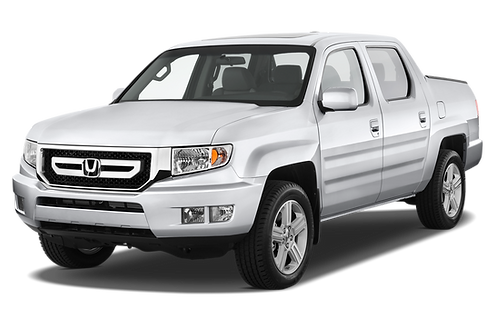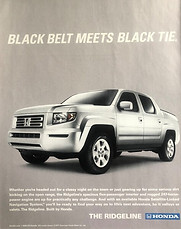
months
12
+27%
Surpassed revised sales projections by
When the audience you want is NOT the audience you need...

Launching the Ridgeline, Honda did two things it had never done before:
One: The company entered the highly competitive U.S. pickup truck market for the first time.
Designed as an SUT ("Sport Utility Truck”), the goal of the Honda Ridgeline was to steal market share from competitors in the large and lucrative U.S. truck category. The advertising showed the Ridgeline plowing through bogs, toting oversized payloads of camping gear, and hauling impressive loads of construction equipment. Right at home in extreme environments of hard work, mud, desert, and snow, the message was clear:
The Ridgeline was a testosterone-fueled war horse!
That’s when Honda did the second thing it had never done before: It failed.
Interest in the Ridgeline was tepid. Dealer traffic was stagnant. Sales lagged. With pressure mounting from Japan, the North American Ridgeline team was in turmoil.
-
The product team blamed to the marketing.
-
The marketing team wanted better advertising.
-
Honda’s ad agency felt that more dealer support might be needed.
-
And the dealers? They didn't like any of it!
Just about everyone felt the price of the Ridgeline was too high for the target audience, but the necessary margins couldn't sustain a price drop. The ad agency even proposed an expensive $150k+ / 10-week research project to study the problem, but there just wasn't budget (or time) for that.
As for me? My involvement began as it almost always does:
I was asked, "How can we fix this...fast?"


DESPERATELY TRYING TO BE SOMETHING WE'RE NOT
The first thing I noticed was that Honda's strategy relied on converting a significant share of traditional pickup truck buyers to the Ridgeline. The marketing math went something like this:
-
The top selling pickup truck in the United States is the Ford F-150.
-
That means, the greatest share of the market to steal is the F-150.
-
So...let's go after their audience: 'Truck guys' in their 20s and 30s.
As I poked around, however, I discovered that no one had asked the most important question: "Would 25-35 year-old 'truck guys' be willing to buy the Honda Ridgeline as a replacement for the F-150?"
The intuitive answer was "No."
PRODUCT: The Ridgeline just didn't fit this shopper's definition of a pickup truck.
-
While standard pickups are 'frame on body,' the Ridgeline was instead a 'unibody design' (think car or minivan).
-
Additionally, while the Ridgeline's 3.5-liter engine was competitive against other V6 motors, Honda didn't offer a V8 option.
-
These two factors alone meant that the Ridgeline's payload and towing capacity fell far short of truck guy expectations.
-
Moreover, the Ridgeline's 4x4 wasn't true 4-wheel-drive...it was just a modified version of Honda's all-wheel drive system.
-
In fact, without the above features, the Ridgeline was a non-starter for the many shoppers who also used their trucks for work.
PERCEPTION: In the U.S., truck guys often define themselves based on the truck brands they choose.
-
Joe is a Chevy guy. Mike is a Dodge man. When he dies, Steve will be buried in his Ford.
-
So, which one of these 4-by-brothers is going to show up to the annual hunting trip driving a new Honda thingamajig?
PRICE: The standard-equipped Ridgeline carried a substantial $35k - $37k price tag.
-
This made it barely affordable for the typical 30 year-old truck guy.
-
What's more, for the same $28k he would spend on a basic 'bare-bones' Ridgeline, our truck guy could purchase an F-150 super cab with an upgraded XLT trim package (including a V8 motor and real 4x4).
Don't get me wrong...I really liked the Ridgeline. And I have tremendous respect for Honda's ability to engineer high quality vehicles.
But, for me, it was just so obvious: From product to perception to price...this younger truck guy was absolutely the wrong audience for this particular vehicle.
But, who was the right audience for the Ridgeline? And what proof did I actually have?
THE DEVIL IS IN THE DATA...
To identify the right audience for the Ridgeline, I felt our best bet was to reverse engineer our profile. That is, we needed to examine (A) who was shopping for the Ridgeline and (B) who was actually buying the Ridgeline. For this, I turned to a couple of trusted partners.
First, I went to Edmunds and Kelley Blue Book - the top auto search-sources at the time. Reviewing their raw online search data, I uncovered a much different mathematical equation.
It went something like this...
-
I found a small, yet powerful blip on the radar screen. There was actually a 1:1 correlation between searches for Honda's Ridgeline and the Ford Explorer Sport-Trac SUV. That is, every time a shopper searched for one of these trucks, they always shopped for the other. "Don't even think about it," the Honda team members told me. "The Sport-Trac is a piece of junk. It doesn't hold a candle to the Ridgeline! They're not even in the same class!" But the correlation was irrefutable.
-
Armed with this, I set out to profile these shoppers. Since this was the launch year of the Honda Ridgeline, there was very little reliable data on Ridgeline shoppers. On the other hand, the Sport-Trac had been on the market for four years, so the information about those shoppers was pretty robust. The data told me that the Sport-Trac shopper was (and logically, the most likely Ridgeline enthusiast / buyer might be) a 56-year-old male with higher income, nearing retirement, with kids in college. "No way," my Honda and agency partners warned me. "You need to stop this already...that's not our customer!" But again, I just couldn't ignore the data.
-
Finally, I sought to understand who was actually buying the Ridgeline. For this, I collaborated with another trusted partner, Honda Financial Services (HFS) - the division of Honda that collects and catalogues all sales data (including finance applications and sales agreements...aka demographic data). The Ridgeline buyer profile was undeniable: Empty Nesters. Average age 54. Most had higher income and/or higher net worth. Nearly one-fifth were retired.
"This may not be your favorite audience," I explained, "But the Ridgeline is their favorite truck!"
The long-term consequences of focusing on this audience? We could debate that later. But if we wanted to reverse lagging sales now, I explained, we needed to connect with these shoppers ASAP!



LEARNING MORE ABOUT OUR WOULD-BE BUYERS
This didn't require the ad agency's $150k / 10-week research proposal. Given the green light, I cut that price in half and finished in 3 weeks.
-
Using buyer email addresses from HFS, we sent out a survey to our Ridgeline owners.
-
The surveys collected valuable information (for example: Sure enough, the Sport-Trac was the #1 competitor considered!). But they also served as a recruitment tool - inviting Ridgeline owners to participate in personal telephone interviews (IDIs).
-
In the end, around 45% of the Ridgeline owners who took the survey checked the YES box and were willing to offer their opinions on the phone (Honda owners are the best!).
What did we find out from the dozens of interviews we completed?



-
The Honda Ridgeline was an ideal mix. To these men, the Ridgeline easily fit their diverse yet specific needs. It was a truck, sure, but with a comfortable ride and plenty of upscale features: Things like a leather interior, hidden access storage boxes, a pre-lined bed, and a recessed electric rear window.
"If I could design a truck for this stage in my life," one owner told us, "the Honda Ridgeline is exactly what I would create."
-
The Ridgeline buyer was transporting garden supplies, small appliances, and luggage...not construction equipment, boulders, or dirt bikes. To them, this was really a practical decision, enhanced by the lightweight diversity of the Ridgeline.
"I love it because I can use it to work on the house on the weekend," another told us, "but it's also great for a comfortable cross-country road trip."
-
As a result, the ad agency's adrenaline-fueled advertising had actually been an initial turn-off. The agency was right that young truck guys really dig heavy-hauling, mud-slinging advertising. But again, this really wasn't the Ridgeline audience. In fact, several owners explained that their purchase of the Ridgeline was an intentional decision to not buy a standard pickup truck. They simply didn't need (nor want) that kind of macho performance.
"If I brought home a Ford F-150 4x4," a customer explained, "My wife would tell me to take it back!"
Even the economics worked: Older affluent customers could more easily afford the more expensive Ridgeline.
A NEW APPROACH
From there...
-
Working with Honda's marketing department and their agencies, we transformed the targeting, shifted the media, and updated the messaging, focusing instead on this older and more affluent audience.
-
Using zip-code-level Scarborough data, we even developed a U.S. map that revealed target-rich environments where concentrations of potential Ridgeline buyers lived (we had found that Ridgelines were actually being shipped to dealers in much weaker markets). To my surprise, Honda actually began diverting shipments of Ridgelines to these more target-dense markets so that dealers could more easily target the middle-aged audience (What a well run and efficient company!).

PERFORMANCE
-
Dealer reports – supported by data from Honda Financial Services – began to reflect stronger foot traffic for the Ridgeline.
-
By mid-year, sales were starting to look up.
-
By year’s end, Honda reported that sales of the Ridgeline had surpassed revised projections by more than +27%.
